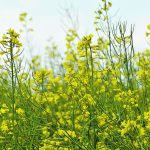SaskCanola amalgamated with the Saskatchewan Flax Development Commission this year to become SaskOilseeds
Free disease testing for farmers, field training days for agronomists and farmer-conducted on-farm research trials were the focuses of SaskOilseeds this past year. Research manager Doug Heath outlined the organization’s 2024 activity at Canola Week, held Dec. 3-5 in Saskatoon and online. ”We work on behalf of canola and flax farmers to fund crop research, […] Read moreTag Archives crop disease — page 2

Blackleg was brutal this year

Crop disease tags along on soybean’s coattails
‘Honeymoon’ period for producers is ending as diseases such as phytophthora root rot make inroads following soybean expansion
Glacier FarmMedia – The worst phytophthora infection that Laura Schmidt of Manitoba Pulse and Soybean Growers has ever seen was just south of Souris. “Probably 25 per cent of the field was impacted,” the production specialist told field day attendees at the Westman Agricultural Diversification Organization near Melita. “One in four plants were dying off, […] Read more
Verticillium stripe in spotlight as threat grows
A U of A study just wrapped up, and four Canola Agronomic Research Program projects are now investigating the disease
Glacier FarmMedia – If you’re a canola grower on the Prairies, you know there are no chemical solutions or varieties to kill or resist soil-borne verticillium stripe disease. You may also know the handful of management practices that can thwart the disease to some extent. And if a crop has been damaged by it, you […] Read more
Disease roundup: Verticillium has breakout year

Bacterial leaf streak disease persists; Alta. crops affected
The disease has caused economic yield losses in a small number of fields, but its presence could become a lingering issue for cereal growers
Bacterial leaf streak is not going away. The disease was present this summer in possibly “hundreds” of irrigated fields of barley, durum and spring wheat in southern Alberta, said Mike Harding, a plant pathologist with Alberta Agriculture. The disease caused economic yield losses in a small number of fields, but its presence could become a […] Read more
Farmers watch as verticillium extends its reach in Sask.
The canola disease appears to be moving west and north after being found in eastern part of the province last year
Anecdotal evidence suggests that verticillium is moving north and west across Saskatchewan. In 2022, Saskatchewan Agriculture staff discovered that verticillium stripe, a disease of canola, was commonplace in the eastern part of the province. This fall, producers in other regions have found the disease in their canola. “I’ve got verticillium in Davidson like you wouldn’t […] Read more
Verticillium spreads in Saskatchewan

Disease survey finds elevated aster yellows levels in Manitoba
Clubroot levels in the province stay low, but a field near Roblin is highly infected with the soil-borne disease
Aster yellows likely reduced canola yields in some Manitoba fields this fall, as the disease was five times more common in 2023 than it was last year. Manitoba Agriculture plant pathologist David Kaminski released preliminary results of the annual canola disease survey for the province during a presentation in early September. About 20 percent of […] Read more






